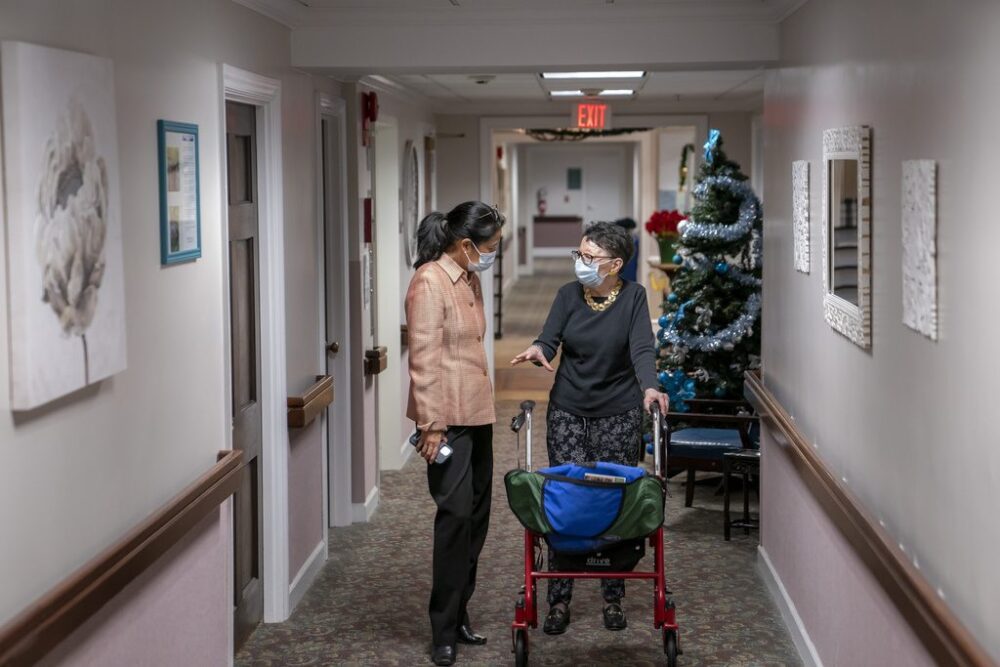
FILE - Tina Sandri, CEO of Forest Hills of DC senior living facility, left, helps resident Courty Andrews back to her room, Dec. 8, 2022, in Washington. The federal government will, for the first time, dictate staffing levels at nursing homes, the Biden administration said Friday, Sept. 1, 2023, responding to systemic problems bared by mass COVID deaths. (AP Photo/Nathan Howard, File)
The US Department of Health and Human Services (HHS) late last month issued several final rules aimed at supporting caregivers, boosting their compensation and job quality, and expanding and improving care options as well as the quality of care in US nursing homes.
These rules build on President Biden’s Action Plan for Nursing Home Reform, which was unveiled in 2022, and his Executive Order on Increasing Access to High-Quality Care and Supporting Caregivers, which was issued in April.
During his third State of the Union address earlier this year, President Biden made commitments to improving the quality of nursing home care; supporting older adults, people with disabilities, and care workers; and strengthening the economy. With these new guidelines, he’s attempting to do just that.
Let’s break down each rule:
Minimum Staffing Standards for Nursing Homes
The first rule establishes, for the first time, national minimum staffing requirements for federally-funded nursing homes.
According to HHS, the rule will “improve the care that residents receive” as well as support direct care workers, or those working face-to-face with nursing home residents, by ensuring that they have the help they need. These direct care roles are overwhelmingly held by women of color.
This new rule will make it so that the over 1.2 million nursing home residents receiving care through Medicare and Medicaid will receive a minimum total of 3.48 hours of nursing care per day, according to HHS. This will include at least 0.55 hours of care from a registered nurse per resident per day, and 2.45 hours of care from a nurse aide per resident per day.
A registered nurse will also now be required to be on site 24 hours per day, seven days per week at federally-funded care homes.
Mary Kay Henry, president of the Service Employees International Union, which represents hundreds of thousands of long-term care workers, called the new rule a “long-overdue sea change.”
“The Biden-Harris administration has taken a major step toward strengthening our long-term care workforce, ensuring quality care for those who need it, and helping every family thrive,” she said in a statement.
These nursing homes will also have to conduct a stronger annual facility assessment than is currently required to determine what additional planning and resources are needed to provide residents with the highest quality of care. And now, that process will include direct care workers. Each of these facilities will also now be required to develop a new staffing plan to maximize retention and recruitment, HHS says.
The Centers for Medicare & Medicaid Services (CMS) will also now require that states collect and report on the percentage of Medicaid payments that are spent on compensation for direct care workers. States will also have to report on the percentage of Medicaid payments that go to support staff in nursing facilities as well as intermediate care facilities for individuals with intellectual disabilities. This data from each care facility will be required to be reported on a state-operated website.
CMS will publicly release this data reported by the states going forward.
The agency is also working on developing a $75 million national nursing home staffing campaign aimed at increasing the number of nursing home workers nationwide. Financial incentives will be provided to nurses who decide to work in these facilities, though there is no word yet on what exactly those incentives will be.
The Biden administration’s decision to implement these new standards came after nearly 47,000 people and organizations submitted comments detailing the current conditions of nursing homes nationwide.
These comments included several horror stories of patients’ experiences, as reported by The Washington Post. These include a nursing home resident who had to purchase a bullhorn with a siren to get the staff’s attention as he was often left sitting in his own stool. Elsewhere, a day shift nurse found a resident choking on his own vomit and having seizures after a night when there had only been one nurse and one aide on duty for 100 residents. A dietician also reported that a nurse at her facility declared a “med holiday” and threw away all the drugs for a shift because the nurses claimed they didn’t have enough time to distribute them.
“Everyone should have equal access to the critical care they need. Our caregivers – those who are taking care of the ones we love – deserve our respect and full support,” HHS Secretary Xavier Becerra said in a statement. “This (rule) will help ensure that millions of people have access to high-quality health care and that the dedicated workers who provide care to our loved ones are fully valued for their work.”
Ensuring Access to Medicaid Services, ‘Access Rule’
Another new Biden administration rule, the “access” rule, will allow people enrolled in Medicaid and the Children’s Health Insurance Program (CHIP) to better access care in a timely manner.
For example, for the first time ever, states will be required to have national appointment wait time standards.
Low-income patients and patients with disabilities on Medicaid have historically faced longer wait times for routine appointments. This is partly because health care providers tend to be less willing to accept Medicaid’s typically lower reimbursement rates.
The maximum wait time for routine primary care for adults and children, as well as obstetric/gynecological services will now be 15 business days. The maximum wait time for outpatient mental health and substance use disorder services for adults and children will now be 10 business days.
States will enforce these standards by conducting “secret shopper” surveys to verify compliance. In other words, people will pose as patients seeking care, and will go and see how a given office operates.
States will also now be required to disclose provider payment rates publicly.
Biden’s plan to reduce Medicaid appointment wait times is already facing pushback; state officials and health insurers are arguing that speeding up wait times is not realistic. Opponents of the rule change argue that the policy does not address the underlying problems of provider shortages.
The Biden administration has acknowledged that provider shortages “present challenges to ensuring timely access,” but federal Medicaid officials say that is part of why standardizing wait times is important, and noted that states can grant exceptions to the requirement if they so choose.
Additionally, a new beneficiary advisory committee will be created in every state, which, according to HHS, “will allow for direct feedback to state Medicaid and CHIP programs on benefits and service delivery from the people who access it daily.”
This rule will also strengthen home and community-based services (HCBS), which millions of older adults and people with disabilities rely upon, by requiring that at least 80% of Medicaid HCBS payments directly compensate direct care workers, instead of administrative expenses.
States will also be required to establish and maintain HCBS wait lists, assess wait times, and report on quality measures going forward. This will in turn take into account small and rural health care providers, as well as protect the health and safety of people who receive home and community care by “improving states’ incident management systems” and requiring “states to have a grievance process” for these patients, according to HHS.
Finally, the rule will set minimum threshold standards for payments to the direct care workforce, and will increase engagement and transparency between workers and consumers.

Surviving cancer in Iowa: Caregivers, advocates share their stories
Cancer in Iowa isn’t just about the research studies and the statistics. Real Iowans and their families are behind each diagnosis. Read our first...

We sent Iowans nitrate tests to check their water. Here’s what they found
This story first appeared in the Sept. 30 edition of the Iowa Starting Line newsletter. Subscribe to our newsletter to get an exclusive first look...

How can policymakers help reduce Iowa’s cancer rates?
This story first appeared in the Sept. 23 edition of the Iowa Starting Line newsletter. Subscribe to our newsletter to get an exclusive first look...

Fighting a health insurance denial? Here are 7 tips to help
By: Lauren Sausser When Sally Nix found out that her health insurance company wouldn’t pay for an expensive, doctor-recommended treatment to ease...

Iowa leads the nation in binge drinking—and faces higher cancer risks from alcohol
This story first appeared in the Sept. 16 edition of the Iowa Starting Line newsletter. Subscribe to our newsletter to get an exclusive first look...

What you can do to reduce your cancer risk: The big six for Iowans
A version of this story first appeared in the Sept. 9 edition of the Iowa Starting Line newsletter. Subscribe to our newsletter to get an exclusive...




